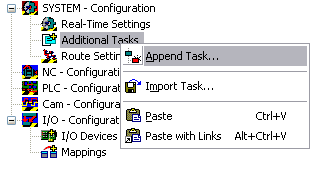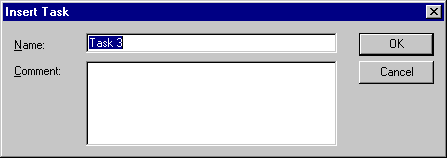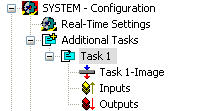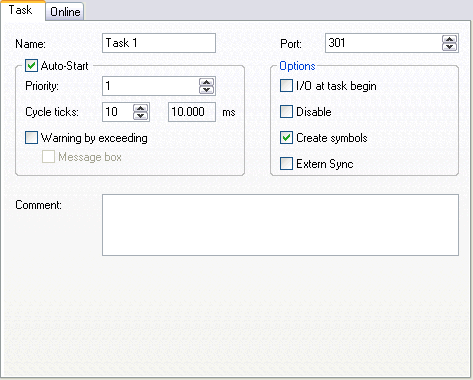User-defined Tasks (Additional Tasks)
Overview
In addition to the four configurable tasks in the PLC runtime systems, the TwinCAT system also supports other (non-PLC) software tasks that can have I/O variables. These tasks are managed in the TwinCAT System Manager under the ”Additional Tasks” option (below ”SYSTEM Configuration” in TwinCAT v2.9). These tasks can be used if a PLC is not available. Variables of these tasks can be accessed directly from applications, such as the TwinCAT OPC Server, Visual Basic, Delphi, VB.NET, VC++, C#.NET, etc., via ADS-OCX, ADS-Dll, or TcADS-DLL.
 | Settings carried out under this option require more advanced knowledge of the TwinCAT system. |
Context Menu

Append Task
Adds another task.
Import Task
Integrates previously created and exported task into the existing system.
Paste
Inserts additional tasks from the clipboard.
Paste with Links
Inserts additional tasks with variable links from the clipboard.
The following dialogue appears after opting to Add a task:

The Name should be selected descriptively at this point. The nature of the user-defined task may also be outlined in a few sentences under Comment.
The new task then appears in the tree. This automatically contains the sub-menu options Process Image, Inputs and Outputs.

Further information about the inputs and outputs is given under: Variable Configuration.
Task Context Menu
A right mouse click on the selected task displays the following context menu:

Export Task
Exports the task configurations with sub-elements and links into a file with the suffix *.tce. It can be thereby imported, as described earlier, into other projects.
Export Header File
Exports the configured input and output variables of the task into a C/C++ header file, for further use in TwinCAT Ring 3 I/O applications.
Cut
Copies the task to the clipboard and removes it from the current configuration.
Copy
Copies the task to the clipboard.
Disabled
Excludes the current task from calculation and editing by the TwinCAT system. Configurations and links are retained and are reactivated when this function is selected once more.
"Task" Dialog
There are different settings options for the tasks in the TwinCAT system. The effects and functions of these options are explained under Task Settings. The following option descriptions are for typical TwinCAT I/O applications.

Port
The ADS Port number of the specific ADS device. At the first additional task this is usually ADS Port number 301.
Auto-Start
Forces the TwinCAT System Manager to create the start command for this task. After start/restart of TwinCAT, this task is going to be started automatically with configured settings.
Cycle ticks
The interval time for this task (with its attached variables) is to be configured here. A mapped Fieldbus (network) adaptor will be refreshed with this task interval then.
Create symbols
Should be activated to enable the symbol upload mechanism for this task e.g. for TwinCAT OPC Server v4 or TwinCAT Scope View. If this taks has e.g. the port number 301, an application like TwinCAT OPC Server v4 can upload the variables by name from this ADS Port number (with AutoCfg option type = 5).